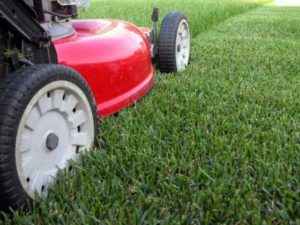Mow Your Lawn at the Right Height
 Mow your lawn at the right height for a healthy lawn. Proper mowing height depends primarily on the type of grass. The rule of thumb is: mow the grass when it grows from 1/4 to 1/3 taller then it’s recommended mowing height. For example, if the recommended mowing height for your lawn is 2 inches, mow when is about 3 inches high.
Mow your lawn at the right height for a healthy lawn. Proper mowing height depends primarily on the type of grass. The rule of thumb is: mow the grass when it grows from 1/4 to 1/3 taller then it’s recommended mowing height. For example, if the recommended mowing height for your lawn is 2 inches, mow when is about 3 inches high.
The penalty for not paying attention to the recommended height is a stiff one. By letting grass grow too high and then cutting away half or more at once, you are expose stems that have been shaded and may burn in strong sunlight. If the lawn is yellowish after you mow, you have waited too long. More importantly, roots are severely shocked by heavy mowing and may need several weeks to recover. Research has shown a direct relationship between the height of the cut and the depth of roots. When grass is properly mowed to it’s recommended height, roots grow deeper. Intern, a deep root system makes lawn care much much easier.
Mow your lawn at the right height
Grasses tend to spread either horizontally or vertically. For instance, Bent grass and Bermuda grass spread horizontally by creeping stems. Because the stems are parallel to the ground as well as the cut of the mower, they are not normally mowed off. Unless these grasses or mowed low preferably with a heavy real mower, they will have problems with thatch.
Think of it this way: X amount of leaf surface is necessary to keep the grass plants healthy and growing. If that Leaf surface spreads out over a wide area, the lawn can be mowed close to the ground without reducing the necessary leaf surface.
Vertically growing grasses, such as by bahai grass, common Kentucky bluegrass, tall fescue, and Saint Augustine grass, cannot be mowed too low, below 1 1/2 2 inches, because they do not have enough leaf surface to support the plants.
Mowing to low probably ruins more Kentucky bluegrass lawns more than any other practice. This is especially true in transitional periods were adaptation is marginal. Cut high, Kentucky bluegrass is more disease resistant and can successfully complete with weeds and insects. The tall growth shades the soil, keeping the temperature lower for cool loving roots.
Exceptions are some of the new Kentucky bluegrass cultivars which are essentially dwarfs. They are more compact and have more leaf surface in less area. In shade mow another 1/2 inch higher.
You can follow any responses to this entry through the RSS 2.0 feed. You can leave a response, or trackback from your own site.


Leave a Reply